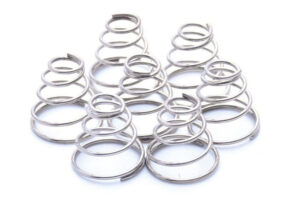Cone Compression Spring
 When it comes to mechanical devices, there are a lot of components that get all the attention. Think about the gears, the motors, and the levers. But what about the cone compression spring? This unsung hero of the mechanical world may not be as glamorous as some of its counterparts, but it is just as important.
When it comes to mechanical devices, there are a lot of components that get all the attention. Think about the gears, the motors, and the levers. But what about the cone compression spring? This unsung hero of the mechanical world may not be as glamorous as some of its counterparts, but it is just as important.
What are Cone Compression Springs?
It is a type of spring that is designed to compress when it is pushed down. It is made up of a cone-shaped wire that is wound around a cylinder. When a force is applied to the top of the spring, it compresses and stores energy. When the force is released, the spring returns to its original shape and releases the stored energy.
How Do It Work?
To understand how cone compression springs work, it’s important to understand a little bit about the physics of springs. All springs have what is known as a spring constant, which is a measure of how much force is required to compress or stretch the spring. The spring constant is determined by the material the spring is made of, as well as its dimensions.
When a force is applied to a spring, it compresses or stretches, and the energy of the force is stored in the spring. The amount of energy that is stored in the spring is equal to the force applied multiplied by the distance the spring compresses or stretches. When the force is released, the spring returns to its original shape and releases the stored energy.
Cone compression springs work in the same way as other springs, but their cone shape gives them some unique characteristics. Because the wire is wider at the base of the cone than at the top, the spring can handle a greater load than a straight compression spring of the same length. This makes cone compression springs ideal for applications where a high load capacity is required in a small space.
Where Can You Find Cone Compression Springs?
They are used in a wide variety of applications, from automotive suspension systems to medical devices. They are particularly useful in applications where space is limited, such as in small engines or electronic devices.
One of the most common applications for cone compression springs is in shock absorbers. When a vehicle hits a bump in the road, the shock absorber compresses and absorbs the energy of the impact. The cone compression spring inside the shock absorber is what allows it to handle the high loads that are generated during this process.
They are also used in medical devices, such as insulin pumps. The spring is used to compress the insulin reservoir, allowing the insulin to be delivered through a catheter to the patient.
Custom Compression Springs Manufacturing
|
Wire Diameter:
|
From 0.1mm-12mm
|
|
Material:
|
Spring steel:carbon steel, middle carbon steel,music wire.
Stainless steel: 301,302,304,316,17-7PH,etc Beryllium Copper, brass, Phosphor Bronze, etc Alloy steel and other custom material available. |
|
Cone Compression Spring Surface Treating:
|
Zinc plating, Nickel plating, Electrophoresis, black oxide, Chrome plating,
Silver plating, Gold plating, Power coating,
Passivation, PVC dipping, etc |
|
Packaging:
|
Inner PE/PP bags, Outer carton, Pallet, wooden crate, tray.
Accept customers’ request. |
|
Other Types:
|
Conclusion
In conclusion, cone compression springs may not be as glamorous as some of their counterparts in the mechanical world, but they are just as important. These unsung heroes are used in a wide variety of applications, from shock absorbers to medical devices, and they play a critical role in making these devices work properly. So the next time you’re using a mechanical device, take a moment to appreciate the cone compression spring that is making it all possible.






